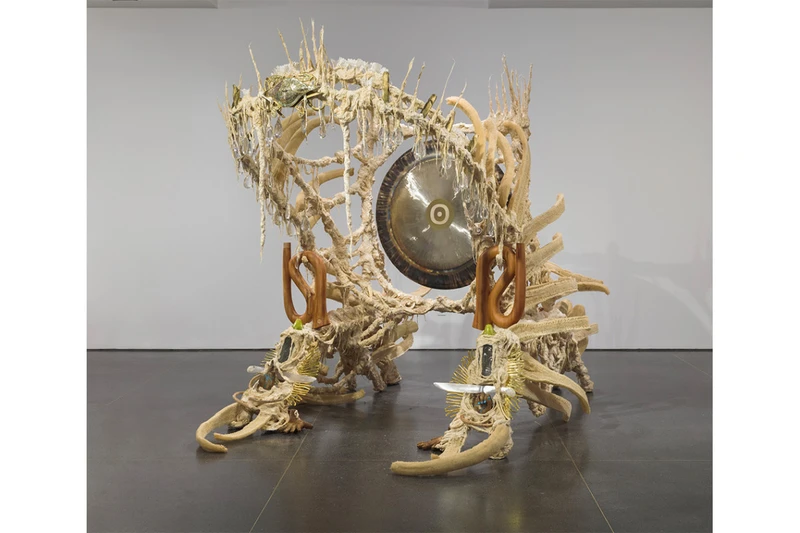Guadalupe Maravilla / Piedras de Fuego (Fire Stones)
26 Oct 2024-15 Feb 2025


Piedras de Fuego (Fire Stones) is the first solo exhibition in the UK of Guadalupe Maravilla and it will transform Talbot Rice Gallery’s Georgian Gallery into a place for recovery and regeneration. Bringing together his remarkable personal journey and teachings from healers and shamans from around the world, Maravilla’s sculptures, paintings and murals are made to be powerful healing instruments.
Through his practice, Maravilla retraces the route he had to take as an eight-year-old undocumented and unaccompanied migrant, fleeing the civil war in El Salvador to make the journey to the United States. This decision, to face places of trauma, was itself informed by another major life event after he was diagnosed with stage three colon cancer and had to find a way to heal more profoundly. Objects collected on this journey become part of Maravilla’s towering shrine-like sculptures, called Disease Throwers, which carry gongs used in sound ceremonies. Sound is incredibly important to Maravilla, who believes it can be used to release the tension and toxins built up in the body that can lead to disease. Piedras de Fuego (Fire Stones) will include a soundtrack of brand new sound performances made by Maravilla, including flute, chimes, harmonica and vocal performances. Providing direct accounts of key moments in his experience, the Retablo devotional paintings give thanks to the miracles and experiences that have happened in his life. They are made, as are many of the works, through commissions and collaborations with different local artisans to create microeconomies. Retablo (twin) recounts the moment the eight-year-old Maravilla was told he had 10 minutes to say goodbye to all his friends as he was about the flee the war.
Volcanic rock is a key part of this exhibition and comprises a series of recent works sculpted by an artisan, Miguel Ángel Peña Cervantes, in Mexico. Entitled Dream Backpacks, they refer to people who immigrate to the US by land in search of the “American Dream” and how they carry everything they own in a backpack. The volcanic rock underlines the weight of the journey, where even a light backpack can become very heavy after traveling so many miles, and the emotional and psychological baggage a person carries. At the same time, Maravilla sees the backpack as a life vest that amounts to all that one has. The material also references a history of displaced people from Central America, where the migratory routes to the United States follow a tectonic line marked by a large number of volcanoes. Additionally, a historic moment when hundreds of thousands of Mayan people were displaced by one of the largest ever volcanic eruptions (circa 540AD). Connected to this, embroidered works include motifs of manos ancestrales (“ancestor’s hands”) that are drawings influenced by his Maya/Mestizo ancestry. His sculptural hammocks in the space offer a place of rest for ancestors.
Linking everything together across the walls of the Georgian Gallery are murals made by playing a game from Maravilla’s childhood, the Tripa Chuca. As an eight-year-old, Maravilla used this game to form relationships with the coyotes (people who help those having to migrate) and grandmothers and other generous people that helped him through his journey. Creating lines that resemble topographical maps or a collaborative fingerprint between two people. Always made with local people who share similar experiences of migration and displacement. This Tripa Chuca will be made with a refugee from El Salvador now based in Scotland.
Biography
Guadalupe Maravilla (b. 1976 in El Salvador, lives and works in Manhattan) has work is in the permanent collections of the Museum of Modern Art, New York, NY; Solomon R. Guggenheim Museum, New York, NY; Whitney Museum of American Art, New York, NY; Museo Nacional Centro de Arte Reina Sofía, Madrid, Spain; Institute of Contemporary Art, Miami, FL; San Francisco Museum of Modern Art, San Francisco, CA; Blanton Museum of Art, Austin, TX; and the Brooklyn Museum, Brooklyn, NY, among others. He has presented solo exhibitions at the Museum of Modern Art, New York, NY; Brooklyn Museum, Brooklyn, NY; Museum of Contemporary Art, Denver, CO; Henie Onstad Kunstsenter, Oslo, Norway; Socrates Sculpture Park, New York, NY; P·P·O·W, New York, NY; and the Institute of Contemporary Art, Miami, FL, among others. His work has been included in recent group exhibitions such as uMoya: The Sacred Return of Lost Things, Liverpool Biennial, Liverpool, UK; soft and weak like water, 14th Gwangju Biennale, Gwangju Metropolitan City, South Korea; Drum Listens to Heart, Part III, CCA Wattis